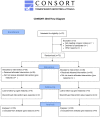Paravertebral Catheter for Three-Level Injection in Radical Mastectomy: A Randomised Controlled Study
- PMID: 26056838
- PMCID: PMC4461276
- DOI: 10.1371/journal.pone.0129539
Paravertebral Catheter for Three-Level Injection in Radical Mastectomy: A Randomised Controlled Study
Abstract
Introduction: Paravertebral block (PVB) is an alternative to general anaesthesia (GA) for breast surgery. However, for extensive surgery multiple punctures are needed increasing the immanent risk of the method. The purpose of this study was to evaluate PVB via catheter and injections at three different levels. Primary outcome was the quality of postoperative analgesia, in particular, the number of patients requiring additional morphine.
Methods: In a randomised single blinded clinical study patients scheduled for breast surgery including axillary approach, were randomly allocated to different anaesthetic techniques, n = 35 each. Patients received either GA with sevoflurane or PVB with catheter at level Th 4. In PVB-patients a 1:2 mixture of bupivacaine 0.5% and lidocaine 2% with adrenaline was injected sequentially 10 ml each at three different levels.
Results: Complication-free catheter insertion was possible in all 35 scheduled patients. The need for postoperative analgesics was higher after GA compared to PVB (22 vs.14 patients); p = 0.056. Postoperative morphine consumption was 1.55 (GA) and 0.26 mg (PVB) respectively (p < 0.001). Visual rating score (VRS) for pain at rest and at movement was higher in GA patients on post anaesthesia care unit (PACU) as well as on the ward at 1-6 h and 6-12 h. Readiness for discharge was earlier after PVB (4.96 and 6.52 hours respectively). After GA the incidence and severity of postoperative nausea and vomiting (PONV) was higher, though not significantly. Patients' satisfaction was comparable in both groups.
Conclusions: Three-level injection PVB via catheter for extensive mastectomy was efficient and well accepted. Using a catheter may enhance safety by avoiding multiple paravertebral punctures when extended spread of analgesia is required.
Trial registration: www.ClinicalTrial.gov NCT02065947.
Conflict of interest statement
References
Publication types
MeSH terms
Substances
Associated data
LinkOut - more resources
Full Text Sources
Other Literature Sources
Medical


